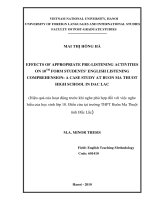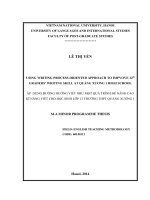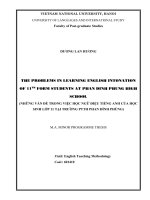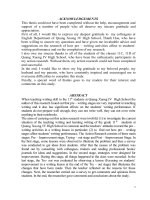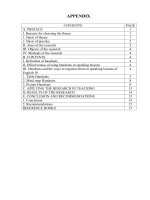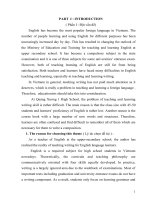Drawing the 10th graders’ attention to writing with pre writing activeties at quang xuong 4 high school
Bạn đang xem bản rút gọn của tài liệu. Xem và tải ngay bản đầy đủ của tài liệu tại đây (332.33 KB, 18 trang )
TABLE OF CONTENTS
A:INTRODUCTION
I. Rationale...................................................................................................…..2
II. Research questions..................................................................................…..3
III.Ojective of the study………………………………………………………..3
IV.Methods of the study...............................................................................…..3
V. Scope of the study....................................................................................…..4
VI. Design of the study..................................................................................3,4
VII. Significance of the study......................................................................….4
B:DEVELOPMENT
I.literature review and theoritial background
1.Prewriting……………………………………………………………………...5
2.Identify the problems………………………………………………………….5
3.Previous researches on prewriting activities................................................5,6,7
1. Summary..................................................................................................….....7
II.Methodology
1.Brainstorming............................................................................................……8
2.Clustering..................................................................................................……9
3.The journalists’question……………………………………………………10
4.Working from an outline...........................................................................…11
III.Effects of applying prewriting activities...........................12,13,14,15,16
C.CONCLUSION
I.Summary of the main finding………………………………………………17
II. Suggetions...............................................................................................…17
REFERENCES...........................................................................................…18
1
A: INTRODUCTION
I. RATIONALE
Together with our country’s integration English takes an extremely important
role in every field,which requires the teachers of English in Vietnam education
systems
in
general
and
high
school
as
well
to
renovate
the
methods,techniques,skills to improve students’ability to speaking,listening and
writing.We communicate with the foreingers in English so we have to listen to
them and talk to them as well.Many people can listen and speak very well but
when being asked to write a report,a description or something else in English
they often feel confused and some even do not know how to write as they want
to express their thought.It is because they only focus on grammar,speaking and
listening at school,many people are bored of writing lesson,some find it difficult
to write so they pay little attention to writing.While teaching at Quang Xuong IV
high school,a school near the sea where many students here come from poor
families with little support from their family for learning,especially English I
find students prefer doing grammartical exercises to listening,speaking and
writing.They do not like writing at all.
Thanks to the innovation of ways in teaching English, English lessons are taught
with four skills (speaking, reading, listening, writing) in one unit. Moreover,
there exists three stages – Pre - while – post - teaching in one lesson. This really
helps students improve their skills beside the grammar exercises to pass the
exams.
When teaching writing skill to the 10 th graders,The lessons having interesting
pre-stage get students more than others which means to me thet pre-writing
stages are very important in teaching writing and it also has significant effects
on the students’writing performance.I have used some activities on teaching prewriting with the hope to draw students’attention to writing and they will be
better and more confident while writing.
2
II. RESEARCH QUESTIONS
1. Do students pay much attention to the pre – writing activities in a
writing lesson?
2. How do pre – writing activities affect the students’ writing
performance?
III. OBJECTIVE OF THE STUDY
Finding the effective techniques in teaching pre-writing stage to be used in
teaching writing at the 10th grade at Quang Xuong 4 high school with the aim of
making students be confident at writing as well as improve this skill
IV. METHODS OF THE STUDY
The study is basically a qualitative research, which employs the following
methods:
1.Collect students’opinions and the sesults of writing skill before using the
activities for pre-teaching
2.Applying the activities in appointed teaching classes,observing the attention of
students,giving writing task,getting the results,taking lesson and experiences
V. SCOPE OF THE STUDY
This study was carried out in three English classes with 120 10 th grade students
at Quang Xuong IV High School in Quang Loi. The research focused on how
pre – writing activities affect the students’ writing performances in writing
lessons.
VI. DESIGN OF THE STUDY
The research consists of three main parts : Introduction, Development and
Conclusion.
Part 1: Introduction presents the rationale, the research questions, the method of
study, the research procedure, the scope of the study, the significance of the
study and the design of the study.
Part 2: Development consists of part one “Literature Review and theoriatical
background” and part two “Methodology”. In part one, the theoretical
3
background of action research are introduced with its definition, three reasons to
use it, and ways to carry it. The concepts of writing, approaches to teaching
writing and some pre – lesson factors affecting students’ writing performance
are also presented in this part. What is more, the writing program for grade 10th
students at Quang Xuong IV High School is described in this part, too. Part two
namely “Methodology” describes the procedure of this action research with the
following main steps: defining the problem, observing class, conducting some
techniques (brainstorming,clustering,the journalists’questions,working from an
outline) and giving out conclusions from findings.
Part 3: Conclusion is the last part which offered a summary and suggestions for
more effective writing activities and some limitations and suggestions for further
studies
VII. SIGNIFICANCE OF THE STUDY
Writing, one of the two productive skills, has always a significant position in
language teaching. Nevertheless, how to teach and learn writing effectively
often poses great problems to both teachers and students. For the teachers of
English at high school, writing is considered a difficult skill to teach. Some of
them even ignore teaching writing skill and focus only on grammar excercises
for the exams. However, nothing is difficult if we, the teachers make decision to
make it easier. Hopefully , with a range of suggestions of how to make pre –
writing activities effectively in writing lessons introduced in this research, it will
be more motivating for the teachers to teach and make progress in teaching
writing Therefore, their students will be interested in writing lessons.
4
B. DEVELOPMENT
I.LITERATURE REVIEW THEORITICAL BACKGROUND
I. Prewriting
For most of us, getting started is often the hardest part of writing. A blank
page, begging to be filled with ink, can be intimidating, especially when our
words come slowly or when our minds go blank. Pre – writing is considered to
be very important in teaching writing. Pre – writing is the paper. In addition, that
Pre – writing is the first stage of the writing process and is also called the idea –
generating stage which stretches back to include anything that you have ever
done or have ever been that might have given you ideas to write about
II.Identify the problems
Nearly all 10th grader students in Quang Xuong IV high school can write a
complete sentence without making error,they have habit of translating into
English words by words from Vietnamese while writing so they often use wrong
words or structures in written Engli
The lack of vocabulary and structures make them hestitate writing,furthermore
students tend to prefer doing grammartical exercises than writing.
III.Previous results of the study
1. Topic for the writing task
“Writing about people’s background-Unit 3,textbook 10 ”
2. Time allowance: 10 minutes (3 minutes for warm – up and 7 minutes for pre
– writing activities)
Class
Teachers’ activities
Students’
Comments
activities
10B
For warm – up:
No
Teacher
pointed
textbook
and
at
asked
effective
the Some of them activities
her said “It is a given,student
students “What is this?” – curriculum
“OK. Today we are going to vitae”.
have little chance
Some to
get
what
a
5
learn how to write about said
nothing, background is in
people’s background”
some kept on an interesting way
For pre – writing stage:
personal talks
Teacher asked her students to
and
no
games,activites
do Task 1, and then she The class was for them to do so
explained some cues given noisy because of they
below the table
easily
feel
the hot weather. bored and make
Teacher asked students to do Most
of
the noise
Task 2 for the while – writing students
did
stage
and
nothing
only some of
them listened to
what the teacher
said
10K
For warm – up:
Students
have
Teacher showed a table of “Yes”
nothing to think
one’s information copied in
about, to discuss
A4 paper and asked the
and
students “Can you see what
challenge them.
nothing
to
do you call this? Is this a
curriculum vitae?”
Students
For pre – writing stage:
seemed
tired
Teacher also asked students and nervous and
to do task 1 in the textbook tried to finish
and then she answered all the their task
questions by herself if there
was
no
reply
from
the
students
Teacher also asked students
6
to do task 2 with no emphasis
on what they had to do to
write
about
peopls’s
background
IV.SUMMARY
The above results show that the pre-writing lacks effective activities and this
situation needs improving,which asks the teachers of English in our school think
it over to find something more effective to get students’attention to writing from
the beginning of the lessons
B: METHODOLOGY
I. BRAINSTORMING
Brainstorming, also called listing, is a process of generating a lot of information
within a short time by building on the association of previous terms you have
mentioned.
Jot down all the possible terms that emerge from the general topic you are
thinking about. This procedure works especially well if you work in a team.
All team members can generate ideas, with one member acting as scribe.
Don't worry about editing or throwing out what might not be a good idea.
Simply write down a lot of possibilities.
Group the items that you have listed according to arrangements that make
sense to you.
Give each group a label. Now you have a topic with possible points of
development.
Write a sentence about the label you have given the group of ideas. Now
you have a topic sentence or possibly a thesis statements
7
II. CLUSTERING
Clustering is also called mind mapping or idea mapping. It is a strategy that
allows you to explore the relationships between ideas.
Put the subject in the center of a page. Circle or underline it.
As you think of other ideas, link the new ideas to the central circle with
lines.
As you think of ideas that relate to the new ideas, add to those in the same
way.
8
The result will look like a web on your page. Locate clusters of interest to you,
and use the terms you attached to the key ideas as departure points for your
paper.
Clustering is especially useful in determining the relationship between ideas.
You will be able to distinguish how the ideas fit together, especially where there
is an abundance of ideas. Clustering your ideas lets you see them visually in a
different way, so that you can more readily understand possible directions your
paper may take
III.THE JOURNALISTS’QUESTIONS
Journalists traditionally ask six questions when they are writing assignments, 5
W's and 1 H: Who?, What?, Where?, When?, Why?, How? You can use these
questions to explore the topic you are writing about for an assignment. A key to
using the journalists' questions is to make them flexible enough to account for
the specific details of your topic. For instance, if your topic is the rise and fall of
the Puget Sound tides and its effect on salmon spawning, you may have very
little to say about Who? if your focus doesn't account for human involvement.
On the other hand, some topics may be heavy on the Who?, especially if human
involvement is a crucial part of the topic. Possible generic questions you can ask
using the six journalists' questions follow:
Who?:
Who are the participants? Who is affected? Who are the primary actors?
Who are the secondary actors?
9
What?:
What is the topic? What is the significance of the topic? What is the basic
problem? What are the issues?
Where?:
Where does the activity take place? Where does the problem or issue have
its source? At what place is the cause or effect of the problem most visible?
When?:
When is the issue most apparent? (past? present? future?) When did the
issue or problem develop? What historical forces helped shape the problem or
issue and at what point in time will the problem or issue culminate in a crisis?
When is action needed to address the issue or problem?
Why?:
Why did the issue or problem arise? Why is it (your topic) an issue or
problem at all? Why did the issue or problem develop in the way that it did?
How?:
How is the issue or problem significant? How can it be addressed? How
does it affect the participants? How can the issue or problem be resolved?
The journalists' questions are a powerful way to develop a great deal of
information about a topic very quickly. Learning to ask the appropriate questions
about a topic takes practice, however. At times during writing an assignment,
you may wish to go back and ask the journalists' questions again to clarify
important points tat may be getting lost in your planning and drafting.
10
IV.WORKING FROM AN OUTLINE
Once you have a general idea of what will go in the introduction, body, and
conclusion of your paper, the next step can be to develop a more specific outline
in which you break down what specifically will be in each paragraph of your
essay. Although some students find it more effective to create an outline based
on a draft that they have already written, creating an outline ahead of time can
help keep your writing more focused than inventing paragraphs as you go.
Either method can create great writing - you might want to experiment with both
methods to see which one works best for you. The purpose of an outline: An
outline helps organize your ideas. An outline presents your material in a logical
form. An outline shows the relationship between the ideas in your writing. An
outline constructs an ordered overview of your writing. An outline defines
boundaries and groups within your paper. An important part of outlining your
ideas is to remain consistent. For example, if you are presenting information or
ideas in a certain order at the beginning of your paper, don't switch that order
half way through your paper. This may confuse your reader. Try to make it
obvious to your readers why and how you are presenting your information so
that they don't have to work at figuring out your organization as they are reading
your paper. Here is an example of an outline covering the topic of rain forest
preservation.
OUTLINE
1.Introduction
A. Square miles
B. Location
C. Thesis:
Because of the valuable characteristics rain forests possess, the rapid
destruction of the forests is creating negative effects on the environment.
2. Characteristics of rain forests
A. Variety of species
B. Value of rain forests
- Medicinal values
- Food values
3. The destruction of rain forests
A. Rate at which rain forests are destroyed
B. Reasons why rain forests are destroyed
- Poverty
- Large company projects
4. Effects on environment
A. Extinction of species
B. Global warming
11
5. Reactions
6. Conclusion
A. Restate thesis
B. Key role
C. Consequences
III. EFFECTS OF APPLYING PRE–WRITING ACTIVITIES
1. Brief description of the results
1.1 Topic for writing essay:
“Writing to give directions”
1.2. Time allowance: 10 minutes
1.3. Class: 10M
Time/
Teachers’ activities
Students’
Comments
Activity
activities
1. Warm – up Teacher comes into -Answer
the
(5’)
the class, turn right question
then turn left .
considered to be
have
successful. After
Teacher asks students come into the
being consulted
“What have I just class and gone
by English
done?
“you
This period is
right and left?
teachers at QX
IV High School
as well as
Discuss
in
Teacher show a big groups to give
picture
conducting the
two try – out
some words or
lessons, teacher
prepositions to
has withdrawn
descibe
the some reasons for
pictures
the success of the
-go up
period
-go down
-go ahead
1. Pre – activity
12
…….
is interesting
2. Visual aids are
effective enough
3. Students
cooperate better
because they are
acquaintances
4. New words
and structures
are taught
logically
5. There is no
2. Pre –
problem with
writing
-Pairwork
activity
1.A:Can
(10’)
students’
you misunderstandin
tell me the way toward teachers’
to ghep market
instructions.
B:Go ahead
2.Could
you
tell me how to
get
to
Soto
Teacher asks students factory?
to ask the way to
B: Go straight
-Ghep market
ahead,turn
-Soto factory
right,it’s on the
corner opposite
a store shop
-Teacher
uses
the -
Discuss
picture shown at warm groups
in
using
13
up(hide the letters ) the
and
introduces words,phrases
somewords,phrases to give by teacher
give directions
to match the
-Asks students to tell symbol
give their words and 1.turn left
asksother
to
give 2.turn right
comment
-Let
3.go ahead
them
check 4.go along
themselves after show
3. While –
the letter hidden
writing
-Each
activity
chose one place
(20’)
group
-Dive the class into to write
groups
-Write to give
- Students can discuss the
direction
in groups and choose according
one place to write
-
Teacher
students
the
to
place
asked chosen
to
make - Students write
sentences basing on direction
in a
the suggestions in the very
good
textbook
-Teach asks
mood with the
students content
to write an outline suggested
in
4. Post –
before writing
the textbook.
- Ask students to work - Students do
writing
in
activity
correction.
pairs
for
peer the
peer
correction
14
(12’)
- Teacher goes around -Show
to
check
their
whether directions then
students can correct give comment
their
classmates’ on other groups
writing.
If
students
need her help, the
teacher will help them
to correct the mistakes
5.Homewo - Give direction to - Write on the
rk
their own houses from notebook
(3’)
the school.
Bellows are some more comments about the improvement of the students in post
– improvement stage:
Pre – improvement
Low
Changes
Students’
Post –improvement
Higher
30% of the students did motivation Most of students were eager to write
not write because they
after the game because they said that
said that the topic was
they liked the game so much
boring. Some of them
were forced to write
basing
on
the
suggestions in Task 1.
They wrote in a bad
form of letter .
More
Ss’
Less
Some students tried to
mistakes
Mistakes
on
grammar
and
follow the suggestions
on both
expressions has improved a lot.
in Task 1 in the textbook
grammar
There still existed some but for the
15
but theirs were full of
and
whole letter they were acceptable
grammar mistakes and expressions because both the teacher and her
words usages
students need more time to perfect
Notes: This may take
these mistakes
longer time to improve
the situation but the
teacher
should
pay
much attention to this
because it is the goal in
teaching a productive
skill
Less creative
Ss’
More creative
Some students in the creativity
Ss’ creativity in writing is another
class did not know what when
hard work to attain and Ss will make
to do with their writings producing
their writing creative when they are
so they copy the whole a
new motivated enough or they feel much
sample letter in the text writing
interested in the writing topic. In the
book
the version
post – improvement the students’
the
writing
ignoring
requirements
of
writing tasks
performance
has
been
improved much.
PART 3: CONCLUSION
I. Summary of the main findings
As evidenced from the previous parts, in the writing classes what the
lessons lack is more effective pre – writing activities prepared by the teacher.
It has also been revealed from the data analysis that I met manydifficulties when
teaching writing lessons without these activities.I chose the way of changing my
16
method and activities with the hope that the students would be more interested
in the writing lessons.I used these techniques in other teachers’classes and got
students’enthusiasm too..
II. suggestions
The study still has some limitations. First of all, this study is very small – scale,
which focuses on only the effects of pre – writing activities on the students’
writing performance so while – writing activities roles are not mentioned here.
Secondly, the area of the study is only restricted to classroom writing in the
textbook published by MOET; thus, any application outside classroom context
requires careful thoughts and consideration. Finally, there were still some
problems that this study is done in a short amount of time so this needs time to
realize the improvement. However, the teacher should pay much attention to this
goal when teaching a productive skill like writing. Hopefully that the above
problems could be solved in other studies after this research in the near future.
LEADER’S CONFIRMATIONS
( XÁC NHẬN CỦA THỦ TRƯỞNG ĐƠN VỊ )
Thanh Hoa, May 26 th 2018
I strongly ensure this is my own work
without copying from any other’s
Writer
Nguyen Thi Hien
REFERENCES
1.English textbook 10.
2. Byrne, D. (1988). Teaching Writing Skills. Longman
3. Raimes,A. (1993). Teachniques in Teaching Writing. OUP.
4. Richards,J.C and Platt, J.,H.(1992).Longman Dictionary of Language
Teaching and Applied Linguistics. Longman.
17
5. Curtis,A.(1988). Action Research: What,How and Why. In The Action
Research Reader. Deakin University
6. Downs,M.(2000). Increasing student Motivation. Teachers’ Edition 4: 8 – 13
7.Leki,I.(1976).Academic Writing, Techniques and Tasks: ST.Martin Press, New
York.
8. Raimes,A. (1993). Teachniques in Teaching Writing. OUP.
18

